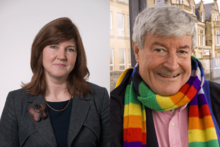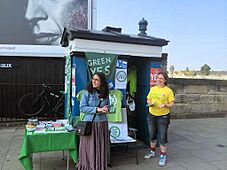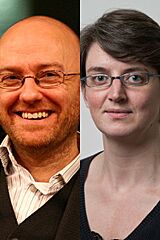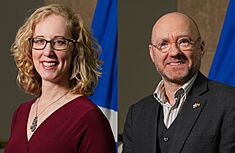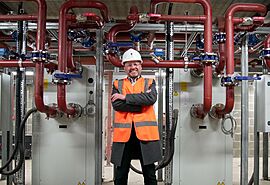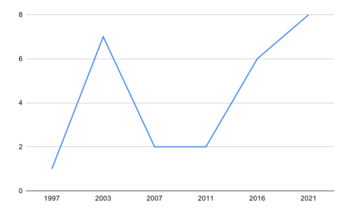Scottish Greens facts for kids
Quick facts for kids
Scottish Green Party
Pàrtaidh Uaine na h-Alba (Scottish Gaelic)
|
|
|---|---|
 |
|
| Co-Leaders |
|
| Council Co-Convenors |
|
| Executive Co-Chairs |
|
| Founded | 1990 |
| Preceded by | Green Party (UK) |
| Headquarters | 17b Graham Street Edinburgh EH6 5QN |
| Youth wing | Scottish Young Greens |
| Women's wing | Scottish Greens Women's Network |
| LGBTQ+ wing | Rainbow Greens |
| Membership (2023) | |
| Ideology |
|
| Political position | Centre-left to left-wing |
| European affiliation | European Green Party |
| International affiliation | Global Greens |
| Colours | Green |
| Slogan | For People. For Planet. |
| Scottish seats in the House of Commons |
0 / 57
|
| Scottish Parliament |
7 / 129
|
| Councillors in Scotland |
35 / 1,227
|
| Election symbol | |
 |
|
| Party flag | |
 |
|
The Scottish Greens are a political party in Scotland focused on protecting the environment. This is often called Green politics. The party also supports Scottish independence, which means it believes Scotland should be its own country. In the Scottish Parliament, the party has 7 out of 129 members, who are called MSPs.
From 2021 to 2024, the Scottish Greens were part of the Scottish Government. They worked with the Scottish National Party (SNP) in a power-sharing deal. This was the first time any Green Party in the United Kingdom had ministers in government.
The party was formed in 1990. It was created when the main UK Green Party split into separate parties for Scotland and for England and Wales. The Scottish Greens are connected with other Green parties around the world through groups like the Global Greens.
After the 2014 Scottish independence referendum, many new people joined the party, making it much larger.
Contents
History of the Party
How the Party Began
The Scottish Green Party started as a part of the Ecology Party in 1978. This later became the Green Party for the whole of the UK. In 1990, the Scottish members decided to form their own separate party, the Scottish Green Party.
That same year, the party won its first election. A Green member named Roger Winter was elected as a councillor for the Highland region.
First Big Wins in Elections
When the Scottish Parliament was created in 1999, the Scottish Greens won their first major seat. Robin Harper became an MSP, making him the first-ever Green politician elected to a parliament in the UK.
In the 2003 Scottish election, the party had a great result, winning six more seats for a total of seven MSPs. This was a big surprise for the party.
However, in the 2007 election, the party lost five of its seats, leaving it with just two MSPs. Despite this, the Greens gained influence. They made a deal with the new SNP government to support Alex Salmond as First Minister. In return, the SNP agreed to pass a new law to fight climate change.
The Independence Referendum and Growth
The Scottish Greens played a big role in the 2014 Scottish independence referendum. The party joined the "Yes Scotland" campaign, arguing that an independent Scotland could create a fairer and greener country. The party's co-leader, Patrick Harvie, said their vision for independence was about building a better future, not just about flags or history.
Although Scotland voted to remain part of the UK, the referendum caused a huge surge in support for the Greens. In the days after the vote, thousands of new members joined the party.
More Success and Brexit
In the 2016 Scottish Parliament election, the party had another successful result, winning six seats. This made the Scottish Greens the fourth-largest party in the parliament. One of the new MSPs, Ross Greer, became the youngest person ever elected to the Scottish Parliament at age 21.
In the 2016 Brexit referendum, the party campaigned for the UK to remain in the European Union. After the UK voted to leave, the Greens began to more strongly support the idea of a second Scottish independence referendum.
First Co-Leaders and Government Ministers
In 2019, the party changed its rules and elected its first-ever co-leaders, Patrick Harvie and Lorna Slater.
The 2021 Scottish Parliament election was the party's best ever, as it won a record eight seats. After the election, the Greens and the SNP agreed to work together to run the country. This deal, called the Bute House Agreement, gave the Greens two minister positions in the government. Patrick Harvie and Lorna Slater became the first Green ministers in UK history.
The agreement ended in April 2024 after a disagreement over climate change targets. The Scottish Government announced it could not meet its goal to cut harmful emissions by 75% by 2030. This led to the end of the power-sharing deal.
What the Scottish Greens Believe In
The party's main ideas are based on green politics, which means protecting the planet. They also support Scottish independence and want Scotland to be a republic, which means having an elected head of state instead of a monarch. The party is also pro-European, meaning it supports close ties with Europe.
The Scottish Greens follow four main principles:
- Ecology: Protecting the environment is key, because when we harm the planet, we harm ourselves.
- Equality: Everyone should be treated fairly. The party fights against discrimination based on gender, race, age, or religion.
- Radical democracy: People should have more say in the decisions that affect their lives.
- Peace and nonviolence: The party believes that violence should be rejected and problems should be solved through cooperation and respect.
What the Party Wants to Achieve
The Scottish Greens have many policies focused on the environment and social fairness.
Climate Change
The party wants strong action to fight climate change. This includes phasing out single-use plastics and banning the sale of new gasoline and diesel cars. They are also against new oil and gas drilling projects in Scotland.
Transport
The Greens want to invest more in public transport like trains and buses. They support expanding Scotland's railway network so that every town with over 5,000 people has a train station. They also want to bring Scotland's railways and bus services into public ownership.
Scottish Independence
The Scottish Greens are the second-largest party in the Scottish Parliament that supports independence. They believe an independent Scotland should have its own currency to have full control over its economy.
LGBT+ Rights
The party is a strong supporter of rights for LGBT+ people. They support making it easier for transgender people to have their gender legally recognised. They also want to ban conversion therapy and improve education about LGBT+ issues in schools.
Party Leadership
The Scottish Greens are led by a team of people, not just one person. The main political leaders are the two co-leaders.
Co-Leaders
The party has two co-leaders who share the top job. At least one of the co-leaders must not identify as a man. The current co-leaders are Patrick Harvie and Lorna Slater. They were first elected in 2019.
| Co-leaders | Term start | Term end | |||
|---|---|---|---|---|---|
| Portrait | Name | Portrait | Name | ||
 |
Patrick Harvie
MSP for Glasgow (2003–present) |
 |
Lorna Slater | 1 August 2019 | Incumbent |
Elected Representatives
The Scottish Greens have members in the Scottish Parliament and on many local councils across Scotland.
Members of the Scottish Parliament (MSPs)
As of 2024, the party has seven MSPs in the Scottish Parliament.
| Portrait | Name | Region |
|---|---|---|
 |
Lorna Slater | Lothian |
 |
Patrick Harvie | Glasgow |
 |
Maggie Chapman | North East Scotland |
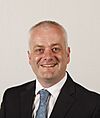 |
Mark Ruskell | Mid Scotland and Fife |
 |
Gillian Mackay | Central Scotland |
 |
Ariane Burgess | Highlands and Islands |
 |
Ross Greer | West of Scotland |
Councillors
The party has also seen growing success in local government. In the 2022 Scottish local elections, the party won a record 35 council seats across Scotland. This was the first time the Greens had elected councillors in areas like North and South Lanarkshire, Shetland, and the Scottish Borders.
Electoral performance
Scottish Parliament
This table shows how many seats the Scottish Greens have won in each Scottish Parliament election.
| Election | Regional Vote | Total seats | +/– | |
|---|---|---|---|---|
| Votes | % | |||
| 1999 | 84,023 | 3.6 |
1 / 129
|
|
| 2003 | 132,138 | 6.9 |
7 / 129
|
|
| 2007 | 82,584 | 4.0 |
2 / 129
|
|
| 2011 | 87,060 | 4.4 |
2 / 129
|
|
| 2016 | 150,426 | 6.6 |
6 / 129
|
|
| 2021 | 220,324 | 8.1 |
8 / 129
|
|
Images for kids
See also
 In Spanish: Partido Verde Escocés para niños
In Spanish: Partido Verde Escocés para niños
- Green politics
- List of environmental organisations
- Renewable energy in Scotland
Related organisations
- European Federation of Green Parties
- Green Party Northern Ireland
- Green Party of England and Wales


